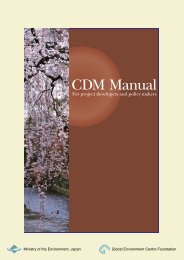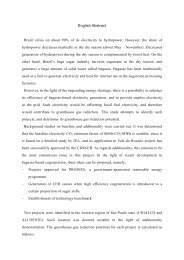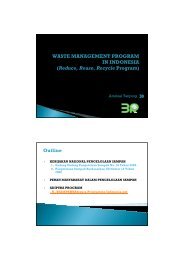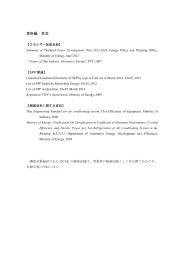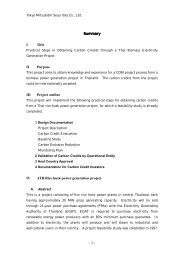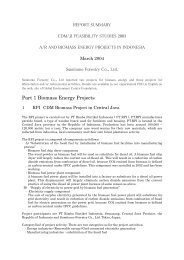PDF File - GEC
PDF File - GEC
PDF File - GEC
Create successful ePaper yourself
Turn your PDF publications into a flip-book with our unique Google optimized e-Paper software.
(g) The step by step calculation<br />
(h) A check against the baseline requirements<br />
(i) Quality control and quality assurance (QA/QC) procedures<br />
(j) Calibration / maintenance of measurement and analytical instruments<br />
(k) Environmental Impacts<br />
(l) An appendix of spreadsheet including parameters, calculations, variations of reduction and its<br />
reasons/ justifications<br />
(3) Pitfalls of monitoring reports<br />
There are difficulties not easily recognized in preparing a monitoring report and having it verified.<br />
Several pitfalls are explained based on experience with verification of monitoring reports. Good<br />
practices are also presented as appropriate.<br />
Pitfall 1: What is indicated in the registered PDD is ideal and hence not reflected in practice.<br />
Good Practice: It must be ensured that what is committed in the monitoring plan of the registered<br />
PDD is actually adhered-to and demonstrated through appropriate evidences. It is advisable to do<br />
the following:<br />
(a) Ensure that the commitments are practicable for implementation by the project participant<br />
and initiate appropriate steps to facilitate implementation of the same. The DOE at the time of<br />
validation should also ensure to verify that systems are in place for such implementation.<br />
(b) An initial verification of the CDM project activity also ensures to dissolve all such<br />
discrepancies.<br />
(c) The process also requires that periodic internal audits be done by the project participant and<br />
corrective actions effected.<br />
Pitfall 2: Systems are not in place. Based on experience, the most common lack of system relates to<br />
the calibration procedures and evidence thereof.<br />
Good Practice: It must be ensured that all relevant procedures – for calibration, maintenance,<br />
internal audits, emergency preparedness, corrective actions and performance reviews must be in<br />
place either at the time of validation stage or during the initial verification. The procedures must<br />
clearly address roles, responsibilities and authorities of all personnel involved.<br />
Pitfall 3: Vast difference in the estimates of the PDD and actual monitoring report, leading to a higher<br />
claim on the CER’s than the estimates in the PDD. It is acceptable only when the CDM project activity<br />
involves an ex-post monitoring of the baseline emissions.<br />
Good Practice: A critical analysis of the gap between ex ante estimated CERs detailed in the PDD,<br />
and the actual CERs claimed in the monitoring report, should be provided in the monitoring<br />
report by the project participants. Such analysis should also be provided in the verification report<br />
by the DOE. In case higher CERs are being claimed due to increased production levels beyond<br />
rated capacities, then this shall also be justified together with technical specifications that support<br />
increased loads beyond the rated capacities.<br />
Pitfall 4: Ex-post monitoring not evident. It is sometimes seen that the monitoring report adopts a<br />
baseline value that has been determined ex-ante.<br />
Good Practice: It is advisable that the PDD, the validation report and the applied approved<br />
methodology are reviewed and understood before embarking on the preparation of the<br />
monitoring report. Internal audit and/or an initial verification of the project activity by the DOE are<br />
also recommended.<br />
17





